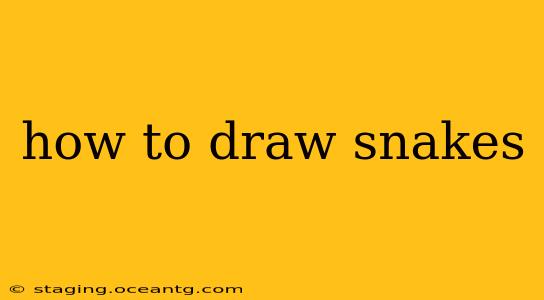Snakes, with their sinuous forms and captivating presence, make for fascinating subjects in art. Whether you're a seasoned artist or just picking up a pencil, drawing snakes can be a rewarding experience. This guide will walk you through various techniques, from simple sketches to more detailed renderings, helping you capture the essence of these slithering creatures.
What Supplies Will I Need to Draw Snakes?
Before you begin, gather your art supplies. You don't need anything fancy to get started! Here's a basic list:
- Paper: Any drawing paper will do, but smoother paper is generally easier for beginners.
- Pencils: A range of pencils (HB, 2B, 4B, etc.) will allow you to vary line weight and shading. A standard HB pencil is a great place to start.
- Eraser: A kneaded eraser is ideal for lifting and blending pencil marks.
- Sharpener: Keep your pencils sharp for clean lines.
- Reference Image (optional but recommended): Having a clear picture of a snake will make the process much easier.
How to Draw a Simple Snake: Step-by-Step Guide
Let's start with a basic snake design. This will help you understand the fundamental shapes and movements involved.
- Start with a simple curve: Draw a slightly S-shaped line. This will form the backbone of your snake.
- Add the body: Extend the curve, gradually thickening the line to create the snake's body. Remember, snakes aren't perfectly uniform in width; they taper slightly.
- Define the head: Create a slightly rounded head at one end of the curve, adding a small, pointed snout.
- Draw the eyes: Simple circles or dots will suffice for the eyes.
- Add details: Once the basic shape is complete, you can add details like scales (we'll cover this in more detail below), a forked tongue, and shading.
How to Draw Snake Scales: Different Techniques
The scales are what give a snake its unique texture. Here are a few approaches to drawing them:
- Individual Scales: This method involves meticulously drawing each individual scale. It's time-consuming but yields a highly realistic result. Start by lightly sketching the outline of each scale, then refine them.
- Rows of Scales: A simpler approach is to draw rows of scales, suggesting their texture without drawing every single one. This is particularly effective for larger snakes or when focusing on other details.
- Textured Shading: Rather than drawing individual scales, you can create the illusion of scales through shading techniques. Use cross-hatching or stippling to add texture to the snake's skin.
What are the Different Types of Snakes and How Do I Draw Them?
There's a huge diversity of snakes, each with unique characteristics. Consider these factors when drawing different species:
- Body Shape and Size: Some snakes are long and slender, while others are short and thick. Observe the proportions and body shape of the snake you're drawing.
- Head Shape: Snake heads can vary significantly. Some are triangular, while others are more rounded.
- Coloration and Patterns: Snakes come in a wide array of colors and patterns. Pay attention to these details to make your drawing more accurate.
Consider researching the specific type of snake you wish to draw to ensure accuracy in your depiction.
How Do I Add Realistic Shading to My Snake Drawing?
Shading is crucial for adding depth and realism to your snake drawing. Here are some tips:
- Light Source: Identify a light source and determine where the highlights and shadows will fall on the snake's body.
- Value Variation: Use varying pencil pressure to create different shades. Darker areas indicate shadows, while lighter areas represent highlights.
- Blending: Use your finger or a blending stump to softly blend the shading for a smoother effect.
How Can I Improve My Snake Drawings Over Time?
Practice is key to improving your snake drawing skills. Here are some suggestions:
- Study Anatomy: Understanding the underlying structure of a snake's body will help you draw it more accurately.
- Practice Regularly: Set aside time to practice drawing snakes, even if it's just for a few minutes each day.
- Seek Feedback: Share your drawings with others and ask for constructive criticism.
- Experiment with Different Styles: Try different drawing techniques and styles to find what works best for you.
Drawing snakes is a journey of exploration and refinement. By following these steps and practicing regularly, you'll be amazed at the progress you can make. Remember to have fun and let your creativity flow!
